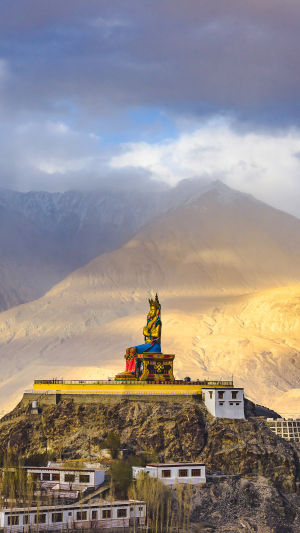Hey Lykkers! Established in the 14th century, Diskit Gompa stands as a beacon of tranquility amid the stunning Himalayan landscape.
Known for its towering Maitreya Buddha statue and panoramic views of the Nubra Valley, Diskit Gompa is a must-visit for travelers seeking spiritual peace and breathtaking scenery.
<h3>How to Get to Diskit Gompa</h3>
To reach Diskit Gompa, the closest town with an airport is Leh, in Ladakh. From Leh, you’ll need to travel by road to reach the Nubra Valley, which is about a 6-hour drive through the picturesque Khardung La Pass—one of the world’s highest motorable passes. Private taxis, shared jeeps, and tour buses are available for the journey, though private vehicles offer more flexibility and comfort for sightseeing along the way.
<h3>Highlights of Your Visit to Diskit Gompa</h3>
<b>The Majestic Maitreya Buddha Statue</b>
One of the main highlights of Diskit Gompa is the 32-meter-high Maitreya Buddha statue, which overlooks the Nubra Valley. This massive statue, painted in vibrant colors, is a symbol of peace and protection for the valley. Positioned against a backdrop of towering mountains, the statue provides an awe-inspiring sight for visitors. It’s also a beautiful location for photography, with views stretching over the valley and river below.
<b>Tour of the Monastery’s Inner Sanctums</b>
Diskit Monastery’s inner sanctums are rich with ancient Tibetan art and relics. As you enter the main prayer hall, you’ll find intricately painted frescoes, age-old statues, and images of Buddhist deities. The monastery is filled with an air of tranquility, where the chants of resident monks echo through the halls, making for an immersive spiritual experience. There’s also a smaller prayer hall with statues of fierce deities meant to protect the monastery.
<b>Breathtaking Views of Nubra Valley</b>
Due to its elevated location, Diskit Gompa offers unparalleled views of the Nubra Valley. From the monastery, you’ll have sweeping vistas of green patches of farmland surrounded by the vast desert landscapes of the valley, all set against the dramatic peaks of the Himalayas. Don’t miss the opportunity to watch the sunset from this viewpoint, as the colors change dramatically over the valley.
<b>Attend the Gustor Festival</b>
If you visit in October, you might be lucky enough to witness the annual Gustor Festival at Diskit Monastery. This festival includes lively Cham dances, where monks don colorful costumes and masks to perform traditional dances, reenacting ancient Buddhist legends. The festival is a unique cultural experience, offering insights into the local beliefs and spiritual customs.
<h3>Accommodation and Dining in Diskit</h3>
<b>Accommodation:</b> Nubra Valley has a variety of accommodations, from cozy guesthouses to luxury campsites. Recommended options include Deskit Villa, Hotel Sten-Del, and Nubra Ecolodge for comfortable stays with scenic views.
<b>Dining:</b> In Diskit, dining options are limited but offer traditional Ladakhi, Tibetan, and North Indian cuisine. Local eateries around the town serve thukpa (noodle soup), momos (dumplings), and butter tea, giving you a taste of authentic Himalayan flavors.
Diskit Monastery | Complete Tour of Diskit Monastery | Nubra Valley | Ladakh
Travel Traveller
<h3>Best Time to Visit</h3>
The best time to visit Diskit Gompa is from May to September, when the weather is milder and more accessible. Winter months can be extremely cold, and access to Nubra Valley may be challenging due to snowfall.
Diskit Gompa is more than just a historical landmark; it’s a place of spiritual peace, cultural immersion, and awe-inspiring natural beauty. The experience of standing before the majestic Maitreya Buddha, walking through ancient halls adorned with Tibetan art, and gazing over the vast Nubra Valley is something that stays with visitors long after they leave. No matter you're a spiritual seeker, a history enthusiast, or simply an adventurer captivated by the Himalayan landscape, a visit to Diskit Gompa promises a truly unforgettable experience in Ladakh.





